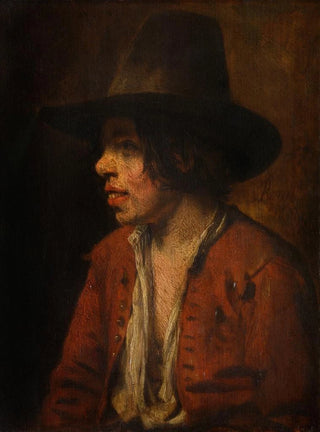Art print | Fisherman - Nicolaes Maes


View from behind

Frame (optional)
In the world of 17th-century Dutch painting, the artwork "Fisherman" by Nicolaes Maes stands out for its ability to capture the very essence of everyday life. This painting, imbued with realism and poetry, transports us to the heart of a peaceful scene where time seems to stand still. The artist invites us to contemplate a fisherman, an iconic figure of nature and labor, engaged in his activity within a bucolic setting. The soft light emanating from the canvas and the meticulous details of the composition evoke in us a nostalgia for simple, yet profoundly human moments. This piece, a true ode to serenity, is sure to appeal to anyone who pauses to look at it.
Style and uniqueness of the work
Nicolaes Maes's style is characterized by striking realism, which transcends mere visual representation to reach an emotional dimension. In "Fisherman," each brushstroke seems to tell a story, with every shadow and reflection adding depth to the scene. The delicate nuances of light, playing on the water's surface and the textures of the fisherman's clothing, reveal an exceptional talent for capturing luminous effects. Maes, faithful to the tradition of Dutch masters, manages to infuse his characters with an inner life, making the viewer a confidant in their daily routine. The composition, carefully balanced, guides the eye and invites a peaceful contemplation, where time stretches and the beauty of nature reveals itself in a new light.
The artist and his influence
Nicolaes Maes, a pupil of Rembrandt, developed a personal style while drawing inspiration from the great masters of his era. His career, marked by works combining intimacy and meticulous observation, left an indelible mark on the Dutch artistic landscape. Focusing on genre scenes, he highlighted the lives of ordinary people, thus revealing the hidden beauty of everyday existence. His influence extends beyond his time, inspiring many artists who followed in his footsteps. Through his sensitive approach and attention to detail, Maes paved the way for a form of pictorial storytelling.

Matte finish

View from behind

Frame (optional)
In the world of 17th-century Dutch painting, the artwork "Fisherman" by Nicolaes Maes stands out for its ability to capture the very essence of everyday life. This painting, imbued with realism and poetry, transports us to the heart of a peaceful scene where time seems to stand still. The artist invites us to contemplate a fisherman, an iconic figure of nature and labor, engaged in his activity within a bucolic setting. The soft light emanating from the canvas and the meticulous details of the composition evoke in us a nostalgia for simple, yet profoundly human moments. This piece, a true ode to serenity, is sure to appeal to anyone who pauses to look at it.
Style and uniqueness of the work
Nicolaes Maes's style is characterized by striking realism, which transcends mere visual representation to reach an emotional dimension. In "Fisherman," each brushstroke seems to tell a story, with every shadow and reflection adding depth to the scene. The delicate nuances of light, playing on the water's surface and the textures of the fisherman's clothing, reveal an exceptional talent for capturing luminous effects. Maes, faithful to the tradition of Dutch masters, manages to infuse his characters with an inner life, making the viewer a confidant in their daily routine. The composition, carefully balanced, guides the eye and invites a peaceful contemplation, where time stretches and the beauty of nature reveals itself in a new light.
The artist and his influence
Nicolaes Maes, a pupil of Rembrandt, developed a personal style while drawing inspiration from the great masters of his era. His career, marked by works combining intimacy and meticulous observation, left an indelible mark on the Dutch artistic landscape. Focusing on genre scenes, he highlighted the lives of ordinary people, thus revealing the hidden beauty of everyday existence. His influence extends beyond his time, inspiring many artists who followed in his footsteps. Through his sensitive approach and attention to detail, Maes paved the way for a form of pictorial storytelling.






